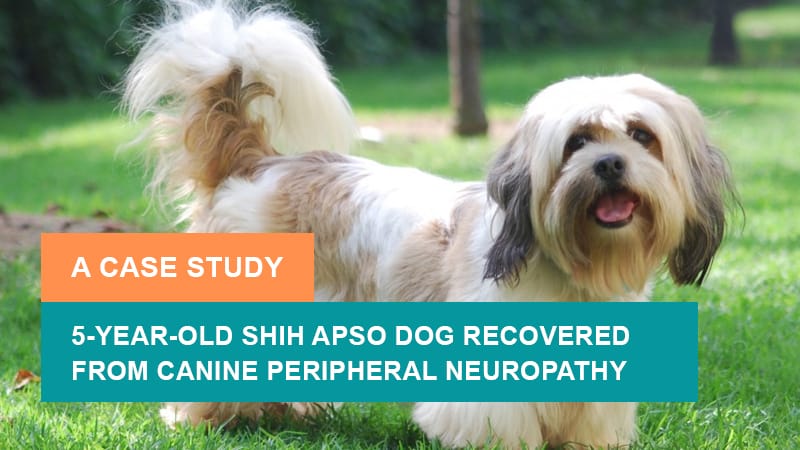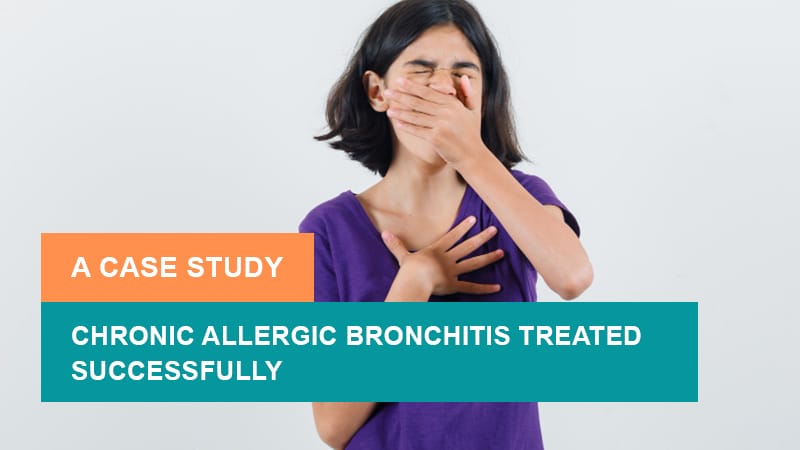Abstract
Peripheral neuropathy is a motor, sensory, and autonomic dysfunction in canines that is often underdiagnosed but is a functionally debilitating condition. This case report presents a 5-year-old female Shih Tzu–Lhasa Apso crossbreed dog with chronic gait instability, generalized neuromuscular weakness, and a history of atopic dermatitis. Despite prior allopathic interventions given to the patient dog, the condition remained progressive, affecting mobility. An integrative approach involving Ayurvedic diagnosis and treatment of this condition, over 17 months, gives gradual neuromuscular improvement. This report will make us understand the therapeutic potential of Ayurvedic Rasayana (rejuvenator), neuro-tonics, and immune modulators in managing various chronic neuropathic conditions in other animals.
Introduction
The group of disorders affecting the peripheral nerves, i.e., the nerves located outside the brain and spinal cord in dogs, is known as canine peripheral neuropathy. These nerves transmit signals between the central nervous system (CNS) and the rest of the body, including skin, muscles, and internal organs. When these nerves become damaged or dysfunctional for any reason, it can lead to a variety of clinical signs in canines, such as weakness of muscle, loss of coordination, decreased reflexes, etc. Peripheral neuropathies in dogs may arise due to various conditions like metabolic disorders, inherited genetic conditions, various infections, toxins, trauma, or immune-mediated diseases. Early recognition and diagnosis are very crucial, as timely intervention can help manage symptoms, improve quality of life, and, in a few cases, nerve damage can be reversed. This case report highlights the role of Ayurveda in addressing both the underlying dosha imbalance in the body of the canine and systemic manifestations of canine peripheral neuropathy.
Case Presentation
Patient Profile
- Name: Bella
- Breed: Canine, Shih Tzu with Lhasa Apso crossbreed
- Age/Sex: 5 years / Female
- Location: Tamil Naidu, India.
- Initial Date of Visit: 16th December 2023
Clinical Complaints
- Progressive gait imbalance, which worsened on inclined or sharp surfaces
- Generalized weakness
- Episodic shivering
- Non-conception despite reaching reproductive maturity due to the above-mentioned complaints.
- Intermittent red and itchy skin eruptions
Medical History
- 1 Year Prior: Respiratory difficulty and atopic dermatitis.
- 1 Month Before First Consultation: Post-trimming skin infection.
- Previous Treatments: Allopathic medicines are taken without lasting improvement.
Clinical Examination and Diagnosis
Ayurvedic Diagnosis
- Indicative of Vata-aggravated neuro-muscular dysfunction or canine peripheral neuropathy (Vataja Vyadhi)
- Chronic skin disease resembling atopic dermatitis (Vicharchika)
- Due to receptivity to mating may be a hormonal disturbance
Modern Correlation
- Canine peripheral neuropathy with underlying neurodegenerative process
- Autoimmune-related canine atopic dermatitis
Treatment Protocol Followed at IAFA Ayurveda
External Therapy
- IAFA 333 Oil: In initial treatment started in December 2023, IAFA 333 oil is given for local application for skin allergies and eruptions over the affected part twice a day and specially applied during allergic response.
Internal Medications
Initially, these three medications started on December 2023
- Ashwagandha (Withania somnifera) Root Extract Capsule – 500 mg, once a day.
- Vilvadi Gulika – One tablet per day with food or water.
- Bhumiamalaki capsules – One capsule per day with food and water.
Follow-Ups #1
After 2 Months, Feb 2024, symptoms remain unchanged, so some changes in treatment are made. External treatment remains the same internally, along with Ashwagandha root extract following medications are added:-
- Saraswatharishtam gold drops – 10 drops with water twice a day.
- Bhoomi Amalaki Capsules – 1 capsule per day with food and water.
- Aam Visha Balance tablet – 1 tablet per day with water.
Follow-Ups #2
In the next follow-up, there is relief in symptoms, and little change is made in treatment.
Externally
- Ksheerabala Oil: Daily gentle massage with Ksheer Bala oil to nourish nerves and relieve Vata especially on legs and all over the body.
Internal Treatment
- Saraswatharishtam gold drops- 20 drops with water twice a day.
- Bhoomi Amalaki Capsules- 1 capsule per day with food and water.
- Aam Visha Balance tablet- 1 tablet per day with water.
Follow-Ups #3
The same treatment is given for approximately 5 months, in which there is some symptomatic relief, and in Oct, 2024, the Respiratory detox tablet twice a day is also added for symptomatic relief from breathing issues.
Follow-Ups #4
Up to January 2025, the same treatment was followed but in January, generalized weakness is present in patients due to a 15 days period which results in weakness in legs again, shaking and gait is also not improved. In Jan 2025, Moringa capsule is added twice a day which is a nutritional antioxidant and also acts as anti-inflammatories. Till now, Bella has been better than before, however his gait is not fully improved but now able to walk. Treatment is still going on.
Ayurvedic Formulations and Their Role in Canine Peripheral Neuropathy
| Ayurvedic Drug | Role |
| Ashwagandha | Rasayana, nerve and muscle tonic |
| Saraswatarishta with Gold | Medhya rasayana, neuromodulator |
| Brahmi | Cognitive enhancer and nervine support |
| Aparajitha | Immunoregulation and detox |
| Moringa | Anti-inflammatory, nutritional antioxidant |
| Aam Visha Balance Tablets | Ama-pachana and systemic toxin clearance |
| Shatavari | Female reproductive support, hormonal balance |
| Respiratory Detox Tabs | Support for respiratory function |
Timeline of Progress (Follow-Up and Outcomes)
| Follow-Up Date | Observations |
| Dec 2023 – Mar 2024 | Reduction in shivering, weakness, gait unchanged |
| Apr – July 2024 | Continued improvement, skin eruptions improvement noticeable |
| Sep – Dec 2024 | Minor relapses post-trimming, Aparajitha and Moringa introduced |
| Jan – May 2025 | Gait is better but not fully recovered, skin is stable. |
Final Outcome (As of May 2025)
- Neuromuscular symptoms were reduced but not completely resolved.
- Skin health is stable with fewer flare-ups.
- General quality of life improved (appetite, activity, mood).
Happy Review of Our Valued Patient (Pet) Owner
IAFA Ayurveda deeply values the trust our patient’s (pet) owner places in us. After completing the treatment, the patient’s owner was kind enough to share their positive experience and satisfaction with the treatment provided by the IAFA Ayurveda.

Their heartfelt feedback not only encourages our IAFA Ayurveda team but also inspires others to seek timely and Ayurvedic treatment for their loved ones.
Discussion
This case represents a classic example of chronic, non-infectious neuropathy, i.e., Peripheral neuropathy in a canine patient. The Ayurvedic diagnosis of Vatavyadhi describes the neuromuscular issue in canine patients.
A long-term Rasayana-based therapy, along with Vata-Shamaka Dravya, Medhya Dravya, etc., gradually improved nerve function. The integration of immune-modulating and detoxifying formulations helps in treating the repeated skin flare-ups classified under Vicharchika.
The generalized weakness after menstruation is due to hormonal imbalance from central or peripheral neural disruption or chronic systemic inflammation. Ayurvedic polyherbal treatment, especially those containing Ashwagandha, Brahmi, Moringa, Saraswatarishta, and Shatavari, proved to be effective in improving systemic strength, reducing neurological symptoms, and supporting homeostasis in the canine patient.
A Detailed Table of Treatment Timeline, Along with the Medication Used and Their Mode of Action
| Timeline | External Medicines | Internal Medicines | Detailed Therapeutic Actions |
| Dec 2023 to Jan 2024 | IAFA 333 Oil (applied twice daily over affected skin) | 1)Ashwagandha capsule (500 mg OD) 2) Vilvadi Gulika (1 tab/day) 3) Bhumi Amalaki capsule (1 cap/day) | IAFA 333 Oil: Soothes allergic inflammation, reduces pruritus, cools the skin, and helps in balancing Pitta and Kapha in skin disorders. Ashwagandha: Acts on the hypothalamic-pituitary-adrenal axis, enhances neuromuscular tone, reduces stress-induced neurotoxicity, and is anti-inflammatory. Vilvadi Gulika: Antitoxic, supports liver and gut detox, useful in hypersensitivity and immune flare-ups. Bhumiamalaki: Hepatoprotective, antiviral, antioxidant; supports skin and metabolic health. |
| Feb to Mar 2024 | IAFA 333 Oil (Continued) | 1)Saraswatarishta Gold (10 drops BID) 2)Aam Visha Balance tab (1/ day)3) Ashwagandha & Bhumi amalaki (continued) | Saraswatarishta Gold: Gold Bhasma enhances neuroregeneration and intellect; acts as Medhya Rasayana and a mild antidepressant. It strengthens synaptic transmission, improves coordination, and memory. Aam Visha Balance: Deepana (appetizer), Pachana (digests Ama), relieves neuroinflammation caused by undigested metabolic toxins. Supports gut-brain axis and systemic detoxification. |
| Apr to July 2024 | 1) IAFA 333 Oil 2)Ksheera Bala Taila (introduced for full body massage, especially limbs) | 1)Saraswatarishta Gold (increased to 20 drops BID) 2) Ashwagandha, Bhumiamalaki, Aam Visha Balance (continued) | Ksheerabala Taila: Nourishes Majja Dhatu (nervous tissue), pacifies Vata, lubricates joints, strengthens muscle tone, relieves spasms and tremors. Increased Saraswatarishta: Boosts CNS function and neuroplasticity. Continued Rasayana and detox approach helps in cumulative strengthening of neuromuscular junctions and calming neuroexcitation. |
| Oct to Dec 2024 | Ksheerabala Taila (continued) | 1)Respiratory Detox tablets (1 tab BID) 2)Aparajitha (added) 3) Ashwagandha, Saraswatarishta, Aam Visha Balance (continued) | Respiratory Detox Tablets: Clears Kapha accumulation from the upper respiratory tract, supports smooth breathing, improves Pranavaha Srotas. Aparajitha (Clitoria ternatea): Medhya and Vishaghna (anti-toxic); modulates the immune system, reduces allergic hypersensitivity, strengthens cellular immunity. Useful in immune-linked skin disorders and neuroinflammation. |
| Jan to May 2025 | Ksheerabala Taila (continued) | 1)Moringa capsules (2/day added) 2) Ashwagandha, Saraswatarishta Gold, Aam Visha Balance (continued) | Moringa (Moringa oleifera): Rich in flavonoids and polyphenols; acts as a neuroprotective antioxidant, anti-inflammatory, and adaptogen. Supports recovery of mitochondrial function and repair of neural membranes. Overall, therapy strengthens Ojas, restores cellular balance, improves neuromuscular resilience, and stabilizes Vata. Gait improvement begins but requires sustained therapy. |
Conclusion
Chronic canine peripheral neuropathy, often labeled idiopathic, may benefit significantly from an Ayurvedic approach when unresponsive to modern treatment. Early identification and long-term constitutional therapy, including Rasayana, Balya, and Medhya Dravya, etc., not only improved neuromuscular strength but also enhanced the animal’s quality of life. Further studies are expected to better understand the use of Ayurvedic formulations for neuropathy and related canine disorders. If you or your loved ones are suffering from any ailment, can consult with our expert online.
References
- Varanasi S, Narayana A. Pashu Ayurveda (veterinary medicine) in Garudapurana Bull Indian Inst Hist Med Hyderabad. 2007; 37: 117– 34.
- Sharma P.V, Charak Samhita Chaukhamba orientalia Varanasi- 221001, Ninth edition, 1: 32. 2
- Murthy. K.r, Asthanga samgraha of vagbhatta, chaukhamba orientalia Varanasi- 221001, ninth edition, 230.
- Bichsel, P ∙ Jacobs, G ∙ Oliver, J Neurologic manifestations associated with hypothyroidism in four dogs. JAVMA. 1988; 92: 1745-1747
- Coates, Joan & O’Brien, Dennis. (2004). Inherited peripheral neuropathies in dogs and cats. The Veterinary clinics of North America. Small animal practice. 34. 1361-401. 10. 1016/ j. cvsm. 2004. 05. 011.
- Cuddon, Paul. (2002). Aquired canine peripheral neuropathies. The Veterinary clinics of North America. Small animal practice. 32. 207- 249. 10. 1016/ S0195-5616 (03) 00086- X.
- DYER, K. & DUNCAN, I. & HAMMANG, J. & Dubielzig, Richard. (2008). Peripheral neuropathy in two dogs: correlation between clinical, electrophysiological and pathological findings. Journal of Small Animal Practice. 27. 133 – 146. 10. 1111/ j. 1748- 5827. 1986. tb02525. x.
- Alexandrova, E. & Kryachko, O. (2024). Determination of the type of peripheral neuropathies using an electroneuromyography in dogs. Legal regulation in veterinary medicine. 105- 107. 10. 52419/ issn- 2782- 6252. 2023. 4. 105.







